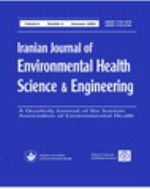
|
Iranian Journal of Environmental Health, Science and Engineering
Iranian Association of Environmental Health (IAEH)
ISSN: 1735-1979
Vol. 2, No. 3, 2005, pp. 189-194
|
 Bioline Code: se05027
Bioline Code: se05027
Full paper language: English
Document type: Research Article
Document available free of charge
|
|
|
Iranian Journal of Environmental Health, Science and Engineering, Vol. 2, No. 3, 2005, pp. 189-194
| en |
EVALUATION OF FERRIC CHLORIDE AND ALUM EFFICIENCIES IN ENHANCED COAGULATION FOR TOC REMOVAL AND RELATED RESIDUAL METAL CONCENTRATIONS
A. Mesdaghinia, M. T. Rafiee, F. Vaezi and A. H. Mahvi
Abstract
Although the removal of colloidal particles continues to be an important reason for using coagulation, a newer objective, the removal of natural organic matter (NOM) to reduce the formation of disinfection by-products (DBPs), is growing in importance. Enhanced coagulation is thus introduced to most water utilities treating surface water. Bench-scale experiments were conducted to compare the effectiveness of alum and ferric chloride in removing DBPs precursors from eight synthetic water samples, each representing a different element of the USEPA's 3×3 enhanced coagulation matrix. The effect of enhanced coagulation on the residual metal (aluminum/iron) concentration in the treated water was assessed as well. The removal of total organic carbon (TOC) was dependent on the coagulant type and was enhanced with increasing coagulant dose, but the latter had no further considerable effect in case of increasing to high levels. For all the treated samples coagulation with ferric chloride proved to be more effective than alum at similar doses and the mean values of treatment efficiencies were 51% and 32% for ferric chloride and alum, respectively. Ferric chloride was therefore considered the better chemical for enhancing the coagulation process. Besides, due to less production of sludge by this coagulant, it would be predicted that treatment plants would be confronted to fewer problems with respect to final sludge disposal. Measurements of residual metal in treated water indicated that iron and aluminum concentrations had been increased as expected but the quality of water concerning the residual metal deteriorated much more in cases of under-dosing. Despite expecting high residual Al and Fe concentrations under enhanced coagulation, metal concentrations were frequently remained low and were not increased appreciably.
Keywords
Drinking water, enhanced coagulation, humic acid, DBPs, residual metal
|
| |
© Copyright 2005 - Tehran University of Medical Sciences Publications
Alternative site location: http://diglib.tums.ac.ir/pub/
|
|
